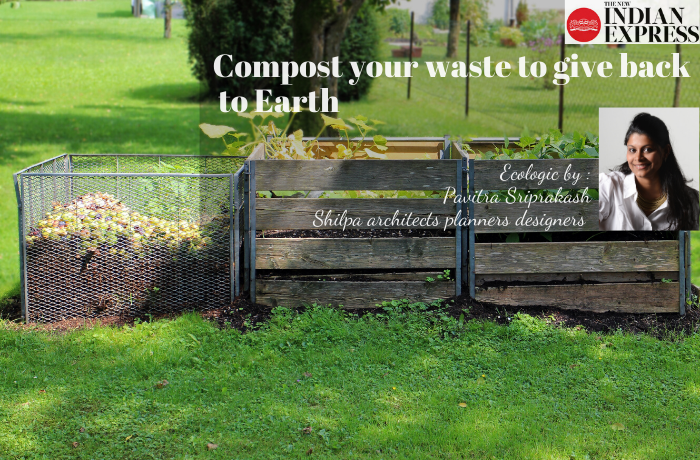26-Nov-2019 : Pavitra Sriprakash, Director and Chief Designer at Shilpa Architects Planners Designers writes a weekly column on Sustainability for The New Indian Express titled “ECOLOGIC”. This week she writes about aerobic or anaerobic composting.
Full article below: (Also available at The New Indian Express Website)
Compost your waste to give back to earth
Did you know that there are different types of composting? Aerobic composting and vermicomposting require ventilation. Anaerobic composting works without oxygen. How do you make compost? What will work better for you and the environment? While considering setting up composting at home for your kitchen waste, there will be few options that you will readily come across in the form of product kits — which offer pots, plastic buckets, different types of ‘accelerator’ powders and coco peat. While most of us will adopt the easiest system, which can be delivered to our homes, a little understanding of what goes into each system is worth knowing before we embark on our composting journey.
Let us start with understanding the role that oxygen has in composting. With the basic understanding that composting is essentially a ‘controlled decomposition’, it is only natural that the process uses air and other natural elements to break down the organic wastes we typically produce from our kitchens. During this controlled decomposition process, bacteria grows — different types of bacteria need different amounts of oxygen for their growth. ‘Aerobic’ means needing oxygen. ‘Anaerobic’ is the opposite: needing little or no oxygen. Both aerobic and anaerobic bacteria break down organic matter. When setting up a system, you will encourage either aerobic or anaerobic bacteria.
Another organism that is great for composting is the earthworm. Composting worms such as Red Worms speed up the composting process. European Night Crawlers are useful for composting and aerating the soil. They are living creatures that breathe through their skins. Therefore, composting with worms (‘vermicomposting’) is aerobic.
Anaerobic composting is typically done in trenches or pits by digging a hole, dumping in the organic material, and covering with soil. This takes more time than aerobic. Also, you cannot tell if the process is complete unless you dig it up. This process releases several gases, including methane. This process may be used by municipalities but rarely is the go-to option for individuals and homes.
Since odour, appearance and ease of composting is important in a household; most small-scale composting is low-odour aerobic composting in a bin. These bins can be placed in shaded areas not directly exposed to the sun as too much sunlight kills the bacteria which are needed for composting to take place. Organic stores and online sites carry a variety of composting bins. These will have air holes to allow a minimal amount of oxygen into it. While the ‘accelerator’ powders introduce the bacteria to help the composting process, it is also necessary to have a healthy mix of green and brown materials. Examples of greens are nitrogen-rich, kitchen veggie scraps while browns can be carbon rich — leaves, coco peat etc.
Vermicomposting uses worms in combination with the greens and browns to create that rich compost material. This type of composting is also low-odour and can be part of a residential compost plan.
Go ahead and find the compost bin that is right for you. Once you start seeing your nutrient-rich compost making a difference to your home garden you will definitely wonder why you did not start composting earlier!



